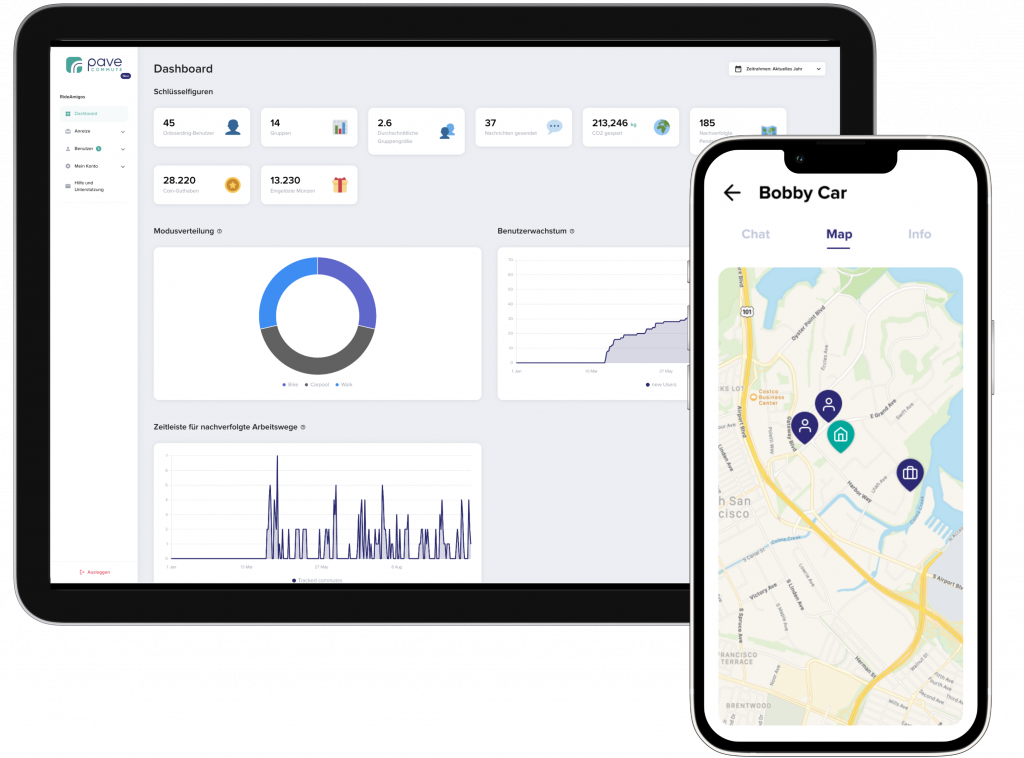The business world is evolving rapidly. Investors, customers, and employees are increasingly demanding that companies take responsibility for the environment, society, and ethical governance. But what does that mean in practice? That’s where ESG comes into play.
In this article, you’ll learn:
- What an ESG program is and why it matters.
- How businesses can achieve ESG goals.
- Why Pave Commute is the ideal partner for your ESG program.
What Does ESG Stand For? A Simple Explanation
ESG stands for Environmental, Social, and Governance. It provides a framework that helps companies define and achieve sustainability goals in three key areas:
- Environmental: How does the company minimize its ecological footprint? Examples include CO₂ reduction, resource conservation, and sustainable supply chains.
- Social: How does the company contribute to society? Examples include fair working conditions, diversity initiatives, and social responsibility projects.
- Governance: How is the company governed? Examples include transparency, ethical practices, and compliance.
Why Are ESG Programs So Important?
Companies that prioritize ESG have significant advantages:
- Attractiveness to Investors: 89% of institutional investors consider ESG criteria in their investment decisions.
- Better Employee Retention: Employees increasingly seek employers that align with their values, with sustainability being a key factor.
- Competitive Edge: Businesses with strong ESG programs stand out positively in their industries.
According to a McKinsey study, companies with robust ESG performance achieve higher long-term profits and avoid risks like regulatory fines and reputational damage.
What Is an ESG Program?
An ESG program is a company’s strategic approach to integrating ESG criteria into its operations. It includes specific actions and goals to promote sustainability across all business areas.
Key Components of an ESG Program:
- Setting Goals: For example, reducing CO₂ emissions from employee commuting by 10 tons annually.
- Defining Actions:
- Promote active mobility through bike-to-work initiatives.
- Simplify and reward carpooling.
- Subsidize public transportation passes.
- Measuring Success: Use monitoring tools and reports to track CO₂ savings and other metrics.
A well-designed ESG program is not just a marketing tool—it demonstrates that a company is committed to protecting people and the planet.
How Pave Commute Fits into Your ESG Program
A critical area for many ESG programs is reducing Scope 3 emissions, which often account for the largest portion of a company’s carbon footprint. These emissions include indirect greenhouse gas emissions, such as those from employee commuting—and this is where Pave Commute shines.
With Pave Commute, companies can:
- Reduce CO₂ Emissions: The app encourages employees to switch to sustainable transport options like carpooling, cycling, or public transit.
- Gain Data-Driven Insights: Pave Commute provides detailed analytics on commuting habits and CO₂ reductions—ideal for ESG reporting.
- Motivate Employees with Rewards: A built-in rewards system makes sustainable commuting fun and engaging.
Results that are impressive
Depending on their size, companies can save considerable amounts of CO₂ every year. You can find more information in our case studies.
Steps to Building a Successful ESG Program
1. Analyze Your Current State
Before starting an ESG program, understand where your company stands. Create an overview of your carbon footprint, social projects, and governance policies.
2. Set Clear Goals
Define SMART goals (specific, measurable, achievable, relevant, time-bound). Example: “Reduce CO₂ emissions from employee commuting by 20 tons by Q1 2026.”
3. Choose the Right Tools
An ESG program requires the right tools. Pave Commute is an excellent partner for managing sustainable employee mobility effectively. Its features enable broad participation, and surveys show that 97% of users feel they’re contributing to their company’s sustainability goals.
4. Communicate Your Progress
Share your ESG achievements with stakeholders. Transparency builds trust and inspires others to follow your lead. Don’t forget to communicate successes internally—employees play a crucial role in reaching these goals.
FAQ: Frequently Asked Questions About ESG Programs
What Does ESG Stand For?
ESG stands for Environmental, Social, and Governance. It outlines criteria that help companies integrate sustainability into their operations.
How Does an ESG Program Benefit My Company?
An ESG program enhances investor appeal, boosts employee motivation, and reduces costs through sustainable practices.
How Does Pave Commute Support ESG Programs?
Pave Commute helps companies reduce CO₂ emissions from employee mobility and encourages sustainable commuting through rewards and transparency.
Go for sustainability and achieve more!
Try Pave Commute with your team free for 30 days. No credit card required.










